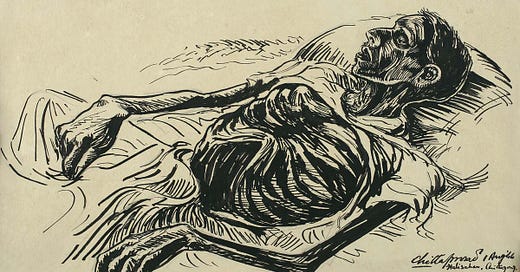Chittaprosad Bhattacharya: The Bengal Famine
The revolutionary artist who became the voice of India’s suffering
In 1943, artist Chittaprosad Bhattacharya (1915 - 1978) produced an extraordinary eyewitness account of the Bengal Famine in a portfolio of 22 stark black and white sketches. The book, called Hungry Bengal: A Tour Through Midnapur District, depicted images of acute impoverishment, that were unseen by the world.
Chittaprosad’s artistic career began in the 1930s, as an illustrator and reporter for the Communist Party of India (CPI). He made propaganda posters, using Socialist tropes, celebrating the oppressed masses and caricatured politicians and colonizers.
But it was in his weekly feature Life Behind the Front Lines in the CPI newspaper, People’s War that he produced his most poignant reportage. Traveling by bus, boat and on foot, Chittaprosad reported on and drew pictures of hunger, illness, forced prostitution, abandoned villages, and uncaring corrupt officials in the famine-struck districts of Midnapore and Bikrampur.

Bengal suffered one of the worst human-derived famines in the world, which killed almost three million people. Given that the Second World War was taking place, the Famine was not covered by international media and was largely denied by the British Colonial powers.
Chittaprosad’s sketches of the people he found are considered one of the few tangible records of this event. His drawings were bold and graphic, yet not without empathy. He drew people with fissures and furrows in their skeletal bodies and eyes filled with despair. He captured the humanity of his subjects, often adding in-depth notes in margins and on the reverse of his sketch paper, that revealed their location, identity and struggles.
In one example, he wrote:
‘’This is hungry, disease-ridden, and virtually naked Rabi Raut, a kisan boy of Kadamdanga village, Balagor, Hooghly district. He has three younger brothers and a sister, all bed-ridden through protozoal infection, scabies, and cough.’’
Chittaprosad was a man fired by a passion to record the pain his people. His drawings show a sensitivity, and also anger at the ruling class that let this happen. He was drawing with a clenched fist.
Keep reading with a 7-day free trial
Subscribe to Illustrated Journalism to keep reading this post and get 7 days of free access to the full post archives.






